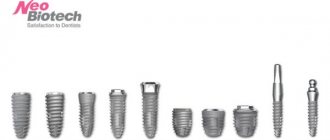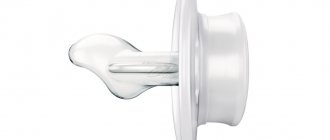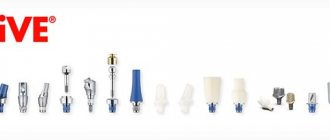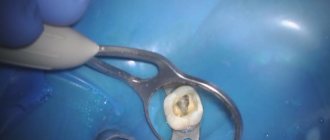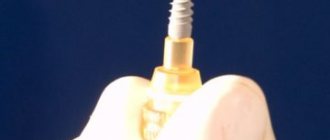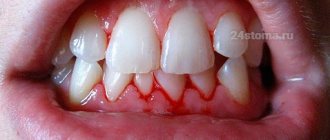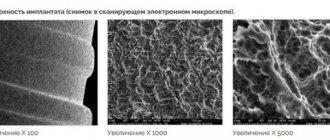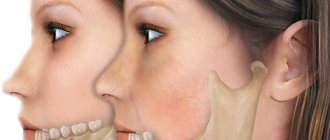History of appearance
The manufacturer of Anyone implants is the South Korean company MegaGen, which is currently at the forefront of the implantology industry in the Asian region. The company was founded in 2002: over the course of several years, research was carried out and the necessary licenses and certificates were issued. MegaGen received wide recognition in 2011, immediately after entering the international market. The Anyridge and AnyOne implant systems quickly became in demand among clinicians, and the products of this manufacturer are currently represented in more than 100 countries around the world.
How did you manage to make such a leap?
- The MegaGen company was founded by Dr. Kwang Bum Pak, a specialist whose name is known not only in South Korea, but also in the USA, where he worked at the Department of Dentistry at Harvard University. He managed to assemble a powerful team of scientists and clinicians with extensive experience in developing products for dental implantation.
- MegaGen's research activities are supported by the South Korean government and major organizations.
- In 2022, the company opened an implant production plant, which became one of the largest in the region and allowed it to increase its turnover many times over.
In Russia, MegaGen implants are also used, although they are still inferior in popularity to their “compatriots” Osstem and Dentium. However, doctors’ reviews of the MegaGen Anyone and Anyridge implants are mostly positive, so there is every reason to believe that they will be offered more and more often in domestic clinics.
Prosthetics using the AnyOne dental system
Before prosthetics, tests are collected and a picture of the jaw is taken. The maxillofacial surgeon and implantologist examine the patient’s clinical case and select the type and size of the implant. Doctors also rule out a patient’s allergy to implant materials and find out whether there are any contraindications to surgery.
The next step is determining the amount of bone tissue. If the disadvantage is minimal, then AnyOne implantation can be combined with a sinus lift. However, if the bone is almost resolved, augmentation will be required.
Surface of AnyOne implants
MegaGen produces two lines of implants - Anyridge and AnyOne. If the former belong to premium products, AnyOne is positioned as an economical system, which, nevertheless, is ready to win competition from more expensive Western implants. Moreover, some of the technological solutions that the company has implemented in the higher-status Anyridge are also used in the production of AnyOne implants, so we can only talk about economy class conditionally.
Special mention should be made of the XPEED coating. This technology can be called the pride of the company, since XPEED was appreciated by the professional community and received a number of prestigious awards specifically for the quality and cleanliness of the surface.
➢ The main technological solution used in the production of XPEED is sandblasting and acid etching (similar to the well-known SLA coating).
➢ A distinctive feature of the XPEED coating is the special nanostructure of CaTiO3, which is obtained by treating the surface with calcium ions. In this way, the activity of osteoblasts is stimulated, which significantly accelerates the formation of bone tissue around the implant and, therefore, reduces the healing time.
Problems to be solved
Implants are used in standard and accelerated dentition restoration protocols. The one-step technique is used in conjunction with an operation to extract the problem unit, which reduces the number of clinic visits. In addition, the design allows the operation to be combined with a sinus lift procedure - increasing the missing volume of bone tissue.
AnyOne pins are also used for ridge splitting - if the width of the area is at least five millimeters, and the method of directed restoration of the bone structure is used. In most situations, clinical indications allow the installation of a temporary crown immediately after implantation.
Advantages and disadvantages
One of the main advantages of the system under consideration is the Xpeed coating, which is a layer of calcium ions that ensures accelerated osseointegration of the prosthesis. Calcium stimulates healing, builds bone mass and improves its structure.
A large selection of sizes, as well as the configuration of the thread applied to the body of the implant, allow the design to be used for any clinical indication. The system allows the combination of implants with different types of crowns and abutments, including products from other manufacturers. Statistics show that the survival rate of AnyOne implants varies in the range of 99.5% - and this can be considered the only disadvantage of the technology, since the likelihood of rejection, albeit minimal, still remains. As a rule, unsuccessful implantation is caused by the characteristics of the patient’s body, or by a violation of the technique of integrating the rods.
Preparation and installation
The protocol for using implants is practically no different from the standard procedure provided for in prosthetics. At the preliminary stage, a comprehensive diagnosis is carried out, excluding medical contraindications, as well as preparing the oral cavity for the placement of an artificial replacement structure. If pathologies are identified, additional treatment is prescribed, upon completion of which the doctor proceeds to the main phase of recovery.
To form the alveolar bed, three types of drills with different diameters are used. If the tissue density is sufficient, it is possible to use a vertical cutter, after which the rod is inserted into the cavity using an implant driver. The pin is immersed 0.5-0.1 mm below the upper edge, after which a temporary crown can be installed, with the help of which a natural physiological load is created.
Design features of AnyOne implants
Anyone implant size range
- The material used is grade 4 titanium
. One of the advanced materials that has high strength and biocompatibility. - Knife Thread.
Knife is translated from English as “knife”, which fully reflects the concept of carving. The aggressive design with an increased area and inclination of the protrusions allows the implant to fit perfectly into the bone and not injure it. Knife Thread provides excellent primary stability and increases the contact area between the implant body and bone. - Tapered neck design
to help retain more bone and prevent bone resorption. - Single orthopedic platform and conical connection.
The company's engineers developed a conical connection between the implant and abutment at an angle of 11 degrees to improve crown fixation and stability of the structure. - R2Guide surgical kit,
which allows you to work according to a template and ensure more accurate implantation.
The length of AnyOne implants can range from 6.5 mm to 15 mm, and the diameter - from 3.5 mm to 7 mm. AnyOne implants can be used in all parts of the jaw with both two-stage and one-stage implantation. For implantation in conditions of bone tissue atrophy (if there are contraindications for bone grafting), the company produces a special implant, AnyOne Special Short.
When is it prescribed?
Most often, dentists use AnyOne when performing a one-stage operation. The structure is also installed at the time of bone tissue augmentation (the composition of the implant promotes rapid tissue regeneration), but the height of the bone must be at least 4 mm.
Sometimes, after splitting the alveolar ridge (if its width is 5 mm or more), an implant with an immediate load is installed in the form of a temporary crown.
Important! The model has several options for the length and thickness of the rod, which allows for an individual approach to solving patient problems.
AnyOne implant installation procedure
Implantation using AnyOne artificial roots follows the same scenario as with other systems.
The treatment method and protocol depend on the individual nuances of the clinical case, the wishes of the patient and, of course, his financial capabilities. This is especially true in case of complete edentia, when the cost of treatment will significantly increase with each implant. The process of implantation and prosthetics consists of several key stages. Ⅰ. Consultation, examination of the oral cavity.
Ⅱ. X-ray or computed tomography of the oral cavity. Identification of contraindications to treatment. In some cases, additional tests may be required.
Ⅲ. Drawing up a treatment plan based on diagnostic results.
Ⅳ. Surgical stage. At this stage, one or more implants are implanted. If the treatment takes place in conditions of complete edentia (the absence of all teeth on one of the jaws), then the operation can take place according to the All-on-4 or All-on-6 protocol, when 4 or 6 implants are implanted into the jaw. In this case, a surgical template is pre-made. For single implantation, the implant can be implanted using a classic two-stage technique with suturing of an artificial root in the gum until complete engraftment, or using a one-stage protocol with the installation of a gum former or temporary prosthesis.
Ⅴ. Orthopedic stage. Permanent prosthetics with a single, bridge or complete prosthesis are carried out after the implants have completely healed. To do this, the procedure of taking impressions (computer modeling) is carried out, after which the permanent prosthesis is made in a dental laboratory.
Stages of complex implantation
- Clinical examination.
To assess the height, density of the alveolar process, the location of important anatomical structures: the maxillary cavity, the mandibular canal, a panoramic image and CT scan are prescribed.
- Surgery
for installation of 4 implants.
- Taking impressions
for the manufacture of temporary conditionally removable prosthesis.
- Fixation of temporary prosthesis.
- After 4-6 months, the temporary prosthesis is replaced with a permanent one.
Advantages and disadvantages of Enivan implants (AnyOne)
- Good price/quality ratio.
- Availability of advanced technologies.
- A very wide range of implants.
- Versatility in prosthetics.
- Positive reviews of Enivan implants from many specialists.
- Lack of long-term studies.
- This brand of implants is quite rare in Russian clinics.
- In difficult cases, doctors usually opt for larger and more well-known brands.
Considering the good reviews for Anyone implants and their attractive price, this brand can strengthen its position in the Russian market over time. The average price for an Anyone implant ranges from 21,000 to 24,000 rubles.
FAQ
What to do if implant rejection begins? How often does this happen?
In practice, cases of rejection are minimal, and if they arose due to a medical error, the problem will be corrected under warranty by selecting an alternative pin material. The situation is much more complicated when the patient himself does not follow the rules of hygiene and nutrition prescribed during rehabilitation, but even in this case, you must immediately contact the dentist for repeated help and not self-medicate!
Is it necessary to undergo a tomography before prosthetics? If there are already implants, is this not dangerous for the body?
It is necessary to undergo a computed tomography scan, because today it is the most reliable way to give a complete picture of the condition of the bone tissue. As for the already installed metal pins, a CT scan will not cause harm to the body, the only negative is that there may be interference in the image. An image with undesirable effects will not prevent a qualified doctor from reading it correctly and making a diagnosis.
What warranty is given for AnyOne implants?
15 years is the minimum service life declared by the manufacturer, regardless of the size and configuration of the pin.
Does it hurt to get implants?
The procedure itself takes place relatively quickly and under high-quality local anesthesia - the patient will feel almost nothing. Once the effect of anesthesia wears off, discomfort, soft tissue swelling and bleeding are possible - an individual case is selected for each case to facilitate the rehabilitation period.
